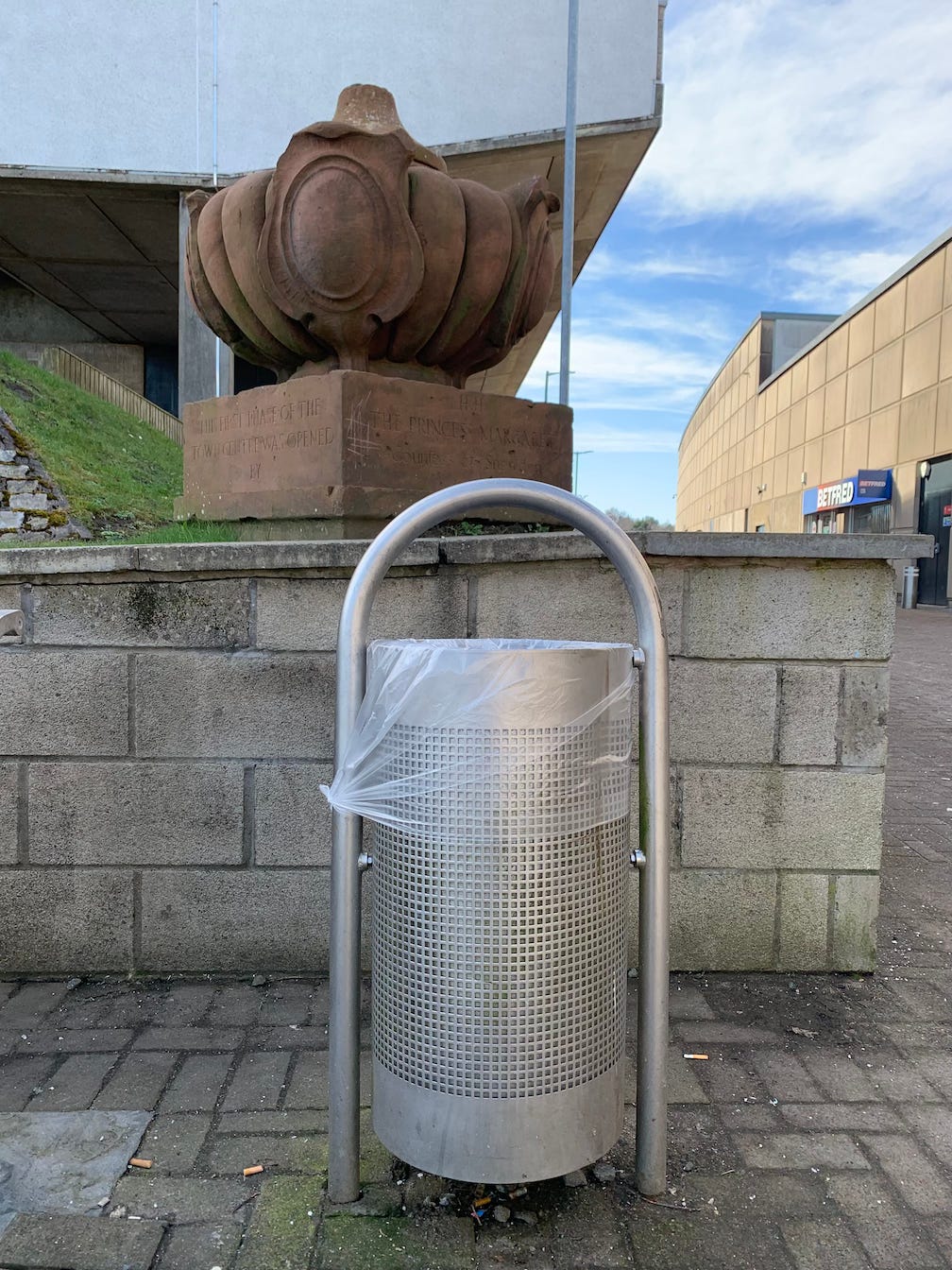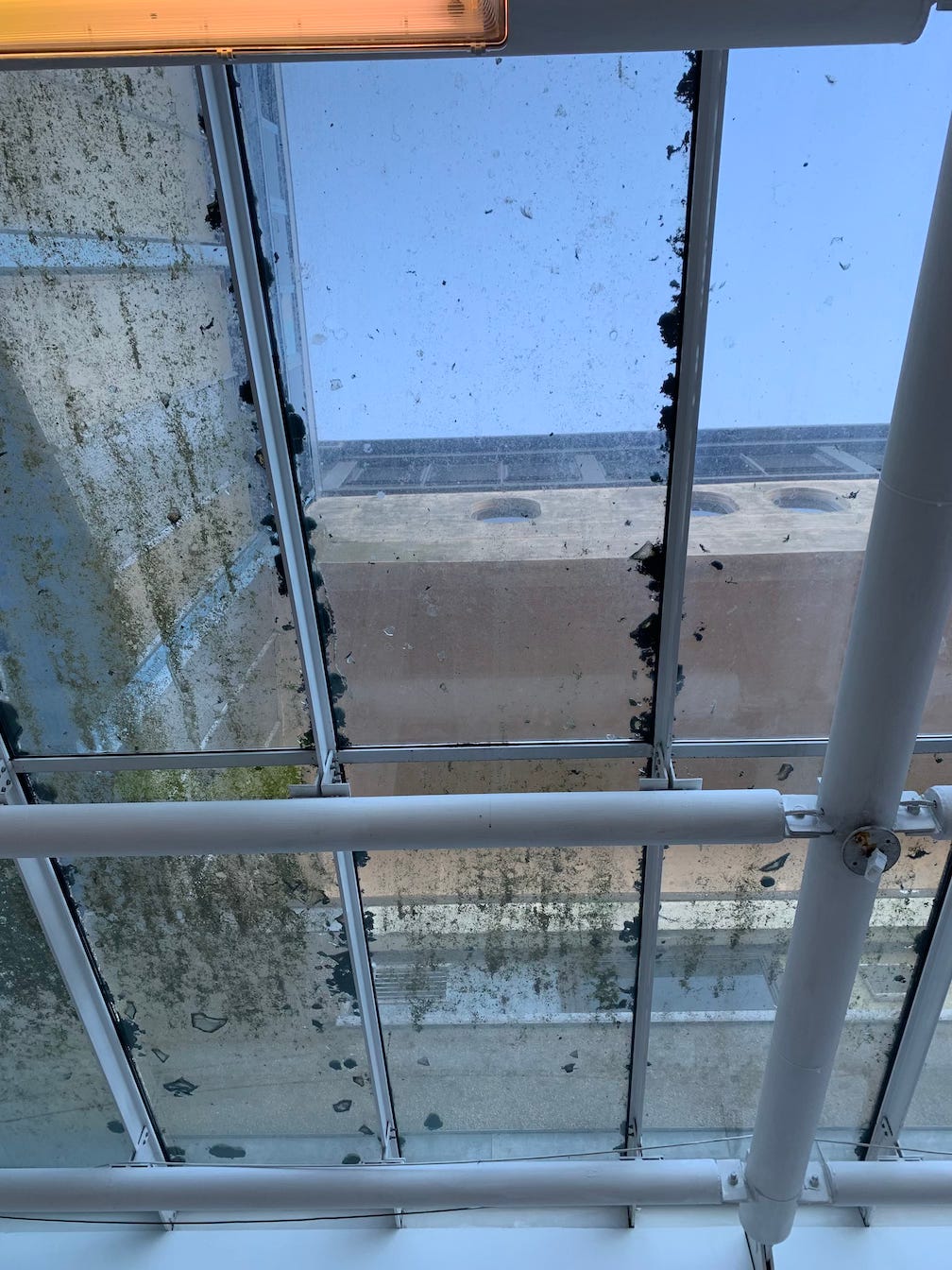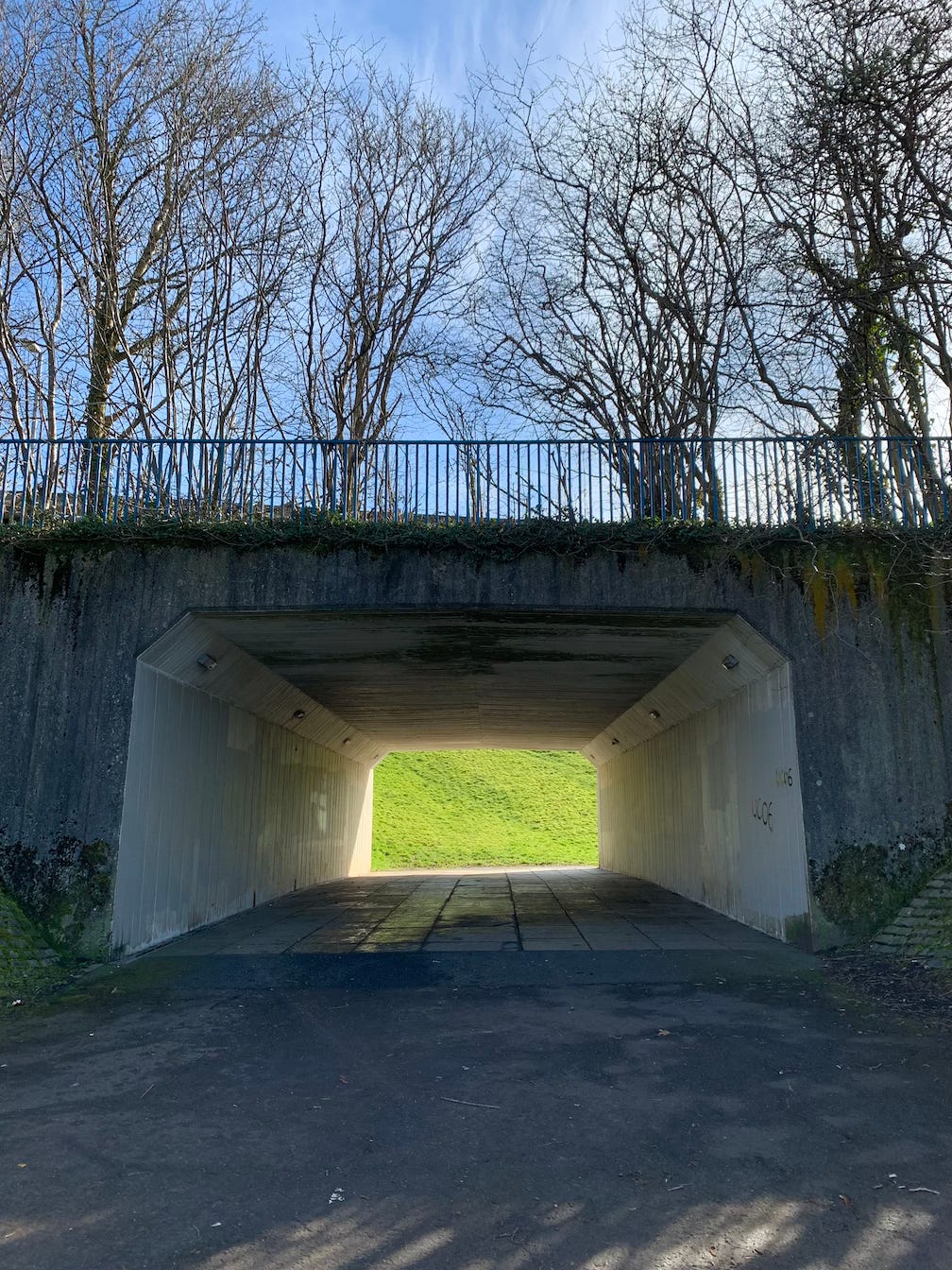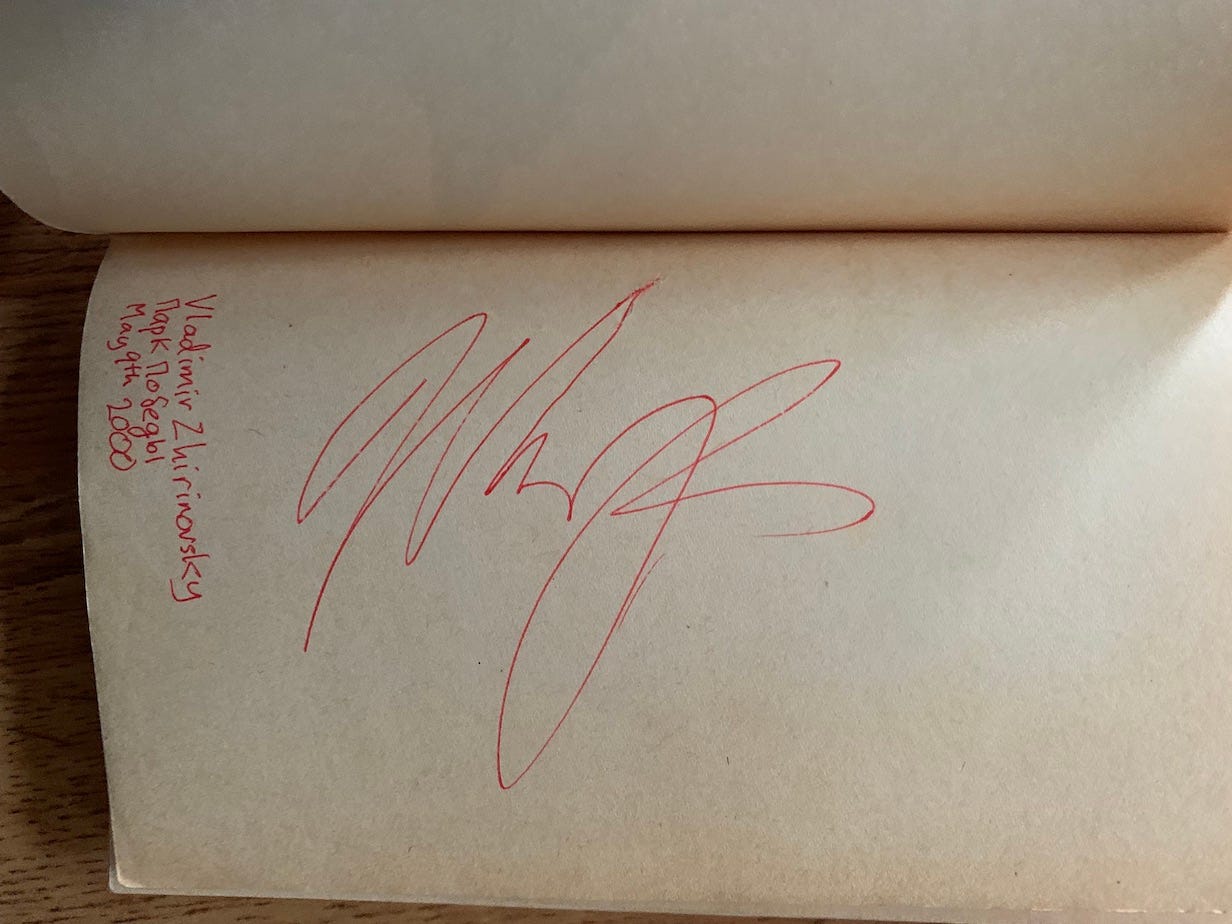The least horrible view of Cumbernauld town centre.
Greetings
In March I was in Scotland, attending to some family business. It was my first Scottish spring in 25 years, and we even had several sunny days, as demonstrated by the photograph above of Cumbernauld’s majestically ugly town centre (more on this legendary carbuncle in a moment).
While I was home I found myself sorting through boxes of old books and other paper ephemera, as well as mementos of my travels that are so bulky and pointless that I have never managed to get them across the Atlantic (I’m looking at you, Soviet-era gas mask). No matter how much I donate to charity or cram into a suitcase, there always seems to be a box of stuff left over, as if it is secretly multiplying its contents while I am not looking.
This time the box managed to duplicate itself entirely and generate a doppelgänger in the attic, or at least that’s what it felt like. In fact, a box that I had thought contained my younger brother’s books instead turned out to be full of mine. Some of them I was glad to see as I thought I had lost them in the depths of my Texas garage: a couple of hardcover collections of Edward Gorey cartoons, for instance. I had forgotten about a 90s era ultra-limited edition signed photo “album” of the Russian author Edward Limonov, but as soon as I saw it I knew it belonged in my library in the US. And then there were books I had no recollection of ever owning, but which definitely seemed like the kind of thing I would have bought back in the day — such as the 1000 page The Encyclopedia of Executions: The Stories Behind Every Execution in 20th Century Britain by John J.Eddleston. I went back and forth on whether or not I ought to keep that one, though eventually I realized that were I to see such a book today I would almost certainly not buy it, as life is short and shelf space is limited. That understanding brought a measure of peace and off it went to the donation pile.
Much more difficult to dispose of were the old notebooks I found that contained hundreds of ideas I had scribbled down in my late teens and early 20s. In those days I feared that one day I would run out of ideas, so I wrote down every single concept, fragment or half-formed notion that came to me. In fact, I have never had any problems tuning into the idea satellite, but I wasn’t to know that back then.
Obviously I was never going to develop any of these decades-old sketches of novels and short stories into finished works, but at the same time I could not bring myself to throw any of them out. Whereas old diaries are boring, records of the imaginative life are not. So I put the notebooks in a suitcase, flew them across the Atlantic… and then put them in a cupboard. My plan is to forget about their existence and let my children dispose of them when I am dead. Well, what else was I supposed to do? Throw them out myself?
Coming up:
A rotted utopia
The Penguin Book of Scottish Verse meets The Alphabet of Sex
THE INFERNAL LIBRARY is published in an actual dictatorship
The Satanic Rites of British Television
A rotted utopia
After the World War II, a number of “New Towns” were built in the UK to rehouse the working classes. Central planners seized the opportunity to realize in concrete their utopian visions of rationally organized communities that would replace the squalid slums of London, Glasgow and other major British cities. Needless to say, the reality turned out to be different from the dream, and many of these utopias are now unloved and rotting. One of the most complete utopian visions was realized in the Scottish town of Cumbernauld, which I visited while I was back home, leading to the essay below. It’s one of my two or three favorite pieces that I’ve written for UnHerd, so I hope you enjoy it.
The heroic failure of Cumbernauld
Cumbernauld is the kind of town you pass through but never stop at. In my youth, I glimpsed the strange concrete structure at its heart from the window of the Glasgow bus many times. But I had no idea that this typically grim example of Sixties brutalism was a building of cultural and historical significance.
Indeed I only found that out last week, when word got out that North Lanarkshire Council had agreed to purchase Cumbernauld’s town centre, but only in order to raze it to the ground. The responses adhered to a familiar script. Architectural historians, of course, were appalled; they argued that, as Britain’s first shopping centre and a radical experiment in building a town centre that went up instead of down, the eight storey “megastructure” was an important part of our cultural legacy. But there was no popular outrage at the news that the rotting eyesore in the centre of the town might soon be gone.
In fact, the destruction of The Centre Cumbernauld (to give it its proper name), which was erected on concrete stilts over the M80 in 1967, has been a dream of many people for a long time. In 2005 it topped a poll of 10,000 people in the UK as the building in Britain that people most wanted to see demolished. Cumbernauld itself, like many of the 27 New Towns that were built in the UK after the war, does not have a great reputation. The comedian Craig Ferguson (who grew up there) once derided it as a “modernist experiment”, where “clueless” town planners had provided “soulless housing for ground-down workers”, before adding that the houses looked like “German machine gun turrets”. My cousins on the west coast of Scotland were pithier: they called it “Scumbernauld”.
Yet for a brief moment in the Sixties and Seventies, Cumbernauld represented an exciting vision of the future, in which a projected population of 70,000 workers and their families would move through the town via a network of pavements, underpasses and bridges. They would never have to cross a road, and never have to spend more than 20 minutes walking to reach the “brilliantly logical” town centre, which housed shops, a library, offices, apartments and even a few penthouses.
When Princess Margaret visited The Centre Cumbernauld in 1967, she pronounced it “fabulous”; that same year it won the Reynolds Memorial Award from the American Institute of Architects. My grandparents lived there in the last years of their lives and greatly preferred their Cumbernauld flat to the one they had lived in on Sauchiehall Street in Glasgow; likewise my Aunt Janet, who lived there between 1972 and 1982, still remembers how novel it was to go shopping without being rained on.
Indeed, even if it had been pouring when I paid a visit last week, I would have remained dry: when I stepped off the bus, I was already inside the centre, confronted with its “brilliant logic”. Is it possible, I wondered, that the architectural historians are right: does Cumbernauld’s town centre deserve to be preserved for future generations? I followed a ramp (there were no stairs or lifts) to the first floor, where I entered the retail complex which had so impressed Princess Margaret 55 years earlier.
The years have not been kind to the place. Where once it featured well-known retailers, such as Halford’s, M & Co. and the supermarket chain Presto, now it is clearly the part of the complex where rents are cheapest (an additional shopping centre, the Antonine, was grafted onto the original building in 2007; that one was opened by Princess Anne); it is here that the eyebrow threaders, tattoo artists, “vintage” shops and suicide prevention centres set up shop. The interior had been remodelled so all traces of its late Sixties utopia-lite origins were gone: bizarrely, the enormous clock from St Enoch’s train station in Glasgow had been embedded in the wall of a mezzanine in the new section, where it kept the time at a permanent 8:20.
After about ten minutes, a security guard informed me that it is forbidden to take pictures in the centre, because it is private property. I moved to the next level, which contains the library and a children’s day-care. This section has not been remodelled; it is very close to the original: lots of brick and tile and concrete, the pipes and wires were exposed. The corridors had names, as if they were streets, but the doors granting entry to them were locked. A service lift was out of order; a weird bench was moulded into the concrete; the glass overhead was filthy. Through it, I could make out the windows of the penthouses, long since abandoned. At the far end, a roof garden for toddlers hung suspended in the air over the dual carriageway beneath.
The library itself was cheerful enough, but overall, I felt as though I had stumbled upon a vision of Logan’s Run as reimagined by Seventies British trade unionists, only the death squads that were supposed to kill you after you turned 30 had all gone, and everyone had long since taken the opportunity to run away, or simply grow older. It was pretty grim.
But if it was grim on the inside, then it was much worse from the outside. Glimpses of Cumbernauld’s town centre from the window of the bus over the years had not done justice to the scale of the architectural catastrophe. It reminded me of the vast Izhmash plant in Udmurtia, Russia, where they pump out AK 47s and other weapons. But Izhmash at least had a decorative historical entrance; with the general absence of windows and the abundance of pipes and wires in the town centre, everything looked like the back of something. The only feature the eye was drawn towards was the long rectangular section with porthole windows suspended on stilts that hung over the road. Locals call it “the alien’s head”.
From there I took a stroll over the bridges and through the underpasses of the town. Certainly it was convenient, though obviously the planners had not thought about the canvas that endless concrete represents to bored teenagers and the threatening atmosphere it can present at night. I was passing through a particularly luminous underpass when I was accosted by a man with a hammer and sickle tattoo on his arm. “They paint it and then it gets graffitied the next day,” he said.
When I asked him how long he had lived in the town, he replied: “Most of my life, on and off. Cumbernauld is a social experiment: it’s driven me doolally. Have you seen the centre? It’s full of people like that.”
Returning, I felt a sense of coercion: the ghostly hand of the planners had arranged everything so that I was more or less obliged to follow the same route through extremely functional housing. Obviously the working classes had no need of freedom, beauty, or variety: they could get by with a few trees. Behold, Le Corbusier’s “machine for living in”, in the Lanarkshire hills….
Read the rest here.
Inscribed urn commemorating Princess Margaret’s visit + bin.
Abandoned penthouses where the masters of Cumbernauld once ate fondue.
One day my son all of this will be yours.
Luminous underpass.
The Penguin Book of Scottish Verse meets The Alphabet of Sex
After several earlier attempts at shuffling off the coil the notorious Russian politician Vladimir Zhirinovsky successfully became a corpse this week. Until recently the bottomless box in my parents’ house contained a book from that brief period in the ‘90s when Zhirinovsky was the next Hitler. It was a shitty instabook of the sort that journalists and media academics knock out in order to cash in on whatever threat to civilization is hot in a given week. I donated it to charity on my last visit home; now I half wish I had kept it.
Anyway, here is a brief article I wrote, also for UnHerd, looking back at the strange career of the erstwhile Mr. Edelshtein.
Vladimir Zhirinovsky: the clown who predicted the Russian invasion
Nobody took this jester-politician seriously — until it was too late
Not long after arriving in Moscow in 1997 I spotted some alarming graffiti close to my apartment building. “LDPR” it read; the initials referred to the “Liberal Democratic Party of Russia” which, despite its anodyne name, was actually a fascist party, headed by the notorious Vladimir Zhirinovsky. Only a few years earlier Zhirinovsky had made headlines worldwide when he threatened to invade Europe and Asia and wage nuclear war on Russia’s enemies. Then he won the largest share of the vote in the country’s first ever democratic parliamentary elections.
This was an early indication that the much hyped economic and political reforms being inflicted upon the Russian populace were not going well, and that a humiliated and angry populace might one day turn to a demagogue for revenge. It turned out however that Zhirinovsky was not that kind of demagogue; in fact, by the late 90s he had already settled into his role as the clown prince of Russian politics, tossing out provocations for shits and giggles, well aware that he would never be in a position to realise any of them.
So it was that when I one day saw Zhirinovsky in person at Moscow’s Victory Park, I thought nothing of walking up to him and getting him to sign my copy of The Penguin Book of Scottish Verse, which I just happened to have in my pocket. The friend I was with, still more brazen, handed Zhirinovsky a copy of Afisha, a nightlife magazine to sign. Zhirinovsky glanced at the cover and then obliged. I don’t think we would have tried the same thing on Putin, not even in his early phase as potential partner to the West.
Despite his penchant for bellicose threats, offensive invective and occasionally getting into fist fights, Zhirinovsky just wasn’t that frightening. Indeed, even when Western papers were hyping him as a Hitler-style evil messiah, he had much more in common with the other post-Soviet self-created men who emerged in the early 90s — the New Age gurus, fake Christs and millionaire coffin magnates. Zhirinovsky was born Vladimir Eidelshtein and had worked for a Jewish organisation in Moscow in the late 80s before reinventing himself as a Russian Mussolini. The minister of security in his shadow cabinet was the novelist-poet-provocateur Edward Limonov (real name: Savenko); he also hung around with the TV faith healer Anatoly Kashpirovsky and the Hungarian-Italian porn star Cicciolina.
Zhirinovsky was a political entrepreneur, an entertainer whose schtick was shock. Although mostly known outside of Russia for his xenophobic outbursts, his routine also incorporated sex. Even as he was threatening to start World War III he claimed to have slept with 200 women. In 1995 he suggested to a US journalist that she might like to have sex with his two bodyguards, and after he had watched for a bit, he would join in. In 1998 he published The Alphabet of Sex, in which Zhirinovsky proposed that that Russia could make money from sex tourism. In 2014, however he did a volte face and suggested that it was only necessary to have sex 3 or 4 times a year (and that everyone should eat more vegetables). Evidently it was time for some new material to keep the act fresh….
Read the rest at UnHerd
The only copy of The Penguin Book of Scottish Verse in the world signed by Vladimir Zhirinovsky
Zhirik’s signature, plus a note to myself commemorating the event. After I die and my children toss this book out, whoever picks it up in a second hand bookstore will be mightily confused.
THE INFERNAL LIBRARY is published in an actual dictatorship
Recently I was delighted to receive copies of the Arabic edition of THE INFERNAL LIBRARY. What made it particularly exciting was that it is the only edition of the book so far to be published in an actual dictatorship, namely Syria.
My original plan for THE INFERNAL LIBRARY included a section on Hafez Al-Assad, but ultimately Saddam Hussein provided me with quite enough material on Ba’athism so I left the Syrian despot out. Had I made a different editorial decision then I doubt very much that the edition published by the good people at the Ninawa Publishing House in Damascus would have become a reality. Nevertheless I do recall that I once received some hate mail through my website that was signed Bashar Al-Assad. It read: “Your writing sucks, and I'm not going anywhere.” Perhaps I should send him a copy.
(NB: I have been migrating earlier installments of Thus Spake Daniel Kalder to Substack and my complete hate mail can now be read here.)
The Satanic Rites of British Television
Before I go, here is a list of the terrible films I watched while I was in the UK because British TV is so unbelievably awful that I found it preferable to trawl the dregs of Amazon Prime and even those weird free channels you get on a Roku than expose my eyes to the new vectors of shit summoned into being by Her Majesty’s commissioning editors.
First, I began with some Nic Cage VOD efforts that have not become cult classics:
Kill Chain (2019)
Running with the Devil (2019)
Arsenal (2017)
Kill Chain had an unusual narrative structure and was actually tolerable, but Running with Devil (also starring Lawrence Fishburne) was so terrible I had to bail on it after 30 minutes. I made two attempts to get more than 40 minutes through Arsenal (also starring John Cusack) but not even Cage’s fake nose could encourage me to keep watching.
I decided to switch to vintage Satanic horror, which led me to watch:
Satanic Rites of Dracula (1973)
The Devil Rides Out (1968)
Set in 1973, Satanic Rites of Dracula was an attempt to bring the exhausted Hammer horror franchise starring Christopher Lee into the modern era. A truly terrible film, it ends when Dracula accidentally runs into a bush to which he is allergic. The Devil Rides Out, also starring Christopher Lee is much better, a piece of high Satanic camp that I highly recommend.
By this point I had had enough of Satan so I went looking for an 80s type video nasty and stumbled upon…
Inseminoid (1981)
This is a low budget Alien knock-off starring Judy Geeson of the 60s classic To Sir, With Love as an astronaut on a mining planet who becomes pregnant by a very cheap looking alien. After that she runs around in a murderous rage, killing and eating her colleagues (one of whom is played by Stephanie Beacham who would later go on to great fame in The Colbys and Dynasty). Inseminoid is high-grade schlock with a truly unfettered performance by Judy Geeson, and much to my surprise I actually enjoyed it; I might even watch it again one day
That’s it from me. My plan is to send out at least one installment of Thus Spake Daniel Kalder a month in 2022 so another one should be winging your way in May… though I might have a stab at the podcast format again before then, we will see.
And lastly, please like, share and subscribe (if you have not already done so) so that more people may discover the joy of Thus Spake Daniel Kalder.
Regards,
DK











